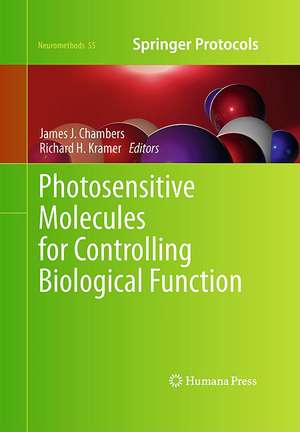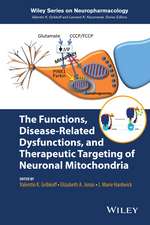Photosensitive Molecules for Controlling Biological Function: Neuromethods, cartea 55
Editat de James J. Chambers, Richard H. Krameren Limba Engleză Hardback – 3 mar 2011
Authoritative and practical, Photosensitive Molecules for Controlling Biological Function provides an unbiased comparison of the various photochemical tools currently available for controlling neuronal activity in order to aid scientists in the vital goal of choosing the right tools for the right job.
| Toate formatele și edițiile | Preț | Express |
|---|---|---|
| Paperback (1) | 894.46 lei 43-57 zile | |
| Humana Press Inc. – 23 aug 2016 | 894.46 lei 43-57 zile | |
| Hardback (1) | 652.31 lei 43-57 zile | |
| Humana Press Inc. – 3 mar 2011 | 652.31 lei 43-57 zile |
Din seria Neuromethods
- 5%
 Preț: 347.57 lei
Preț: 347.57 lei - 15%
 Preț: 659.53 lei
Preț: 659.53 lei - 15%
 Preț: 665.08 lei
Preț: 665.08 lei - 18%
 Preț: 986.63 lei
Preț: 986.63 lei - 24%
 Preț: 852.89 lei
Preț: 852.89 lei - 18%
 Preț: 953.03 lei
Preț: 953.03 lei - 18%
 Preț: 955.25 lei
Preț: 955.25 lei - 20%
 Preț: 1129.36 lei
Preț: 1129.36 lei - 20%
 Preț: 1252.04 lei
Preț: 1252.04 lei - 18%
 Preț: 1291.45 lei
Preț: 1291.45 lei - 15%
 Preț: 652.31 lei
Preț: 652.31 lei - 18%
 Preț: 955.70 lei
Preț: 955.70 lei - 23%
 Preț: 705.39 lei
Preț: 705.39 lei - 18%
 Preț: 973.38 lei
Preț: 973.38 lei - 18%
 Preț: 964.86 lei
Preț: 964.86 lei - 18%
 Preț: 968.03 lei
Preț: 968.03 lei - 15%
 Preț: 662.95 lei
Preț: 662.95 lei - 15%
 Preț: 646.43 lei
Preț: 646.43 lei - 15%
 Preț: 649.71 lei
Preț: 649.71 lei -
 Preț: 395.29 lei
Preț: 395.29 lei - 19%
 Preț: 580.67 lei
Preț: 580.67 lei - 19%
 Preț: 584.12 lei
Preț: 584.12 lei - 19%
 Preț: 566.41 lei
Preț: 566.41 lei - 15%
 Preț: 652.17 lei
Preț: 652.17 lei - 15%
 Preț: 655.13 lei
Preț: 655.13 lei - 18%
 Preț: 959.36 lei
Preț: 959.36 lei - 15%
 Preț: 652.49 lei
Preț: 652.49 lei - 15%
 Preț: 649.54 lei
Preț: 649.54 lei - 15%
 Preț: 649.87 lei
Preț: 649.87 lei - 15%
 Preț: 650.19 lei
Preț: 650.19 lei - 15%
 Preț: 648.42 lei
Preț: 648.42 lei - 18%
 Preț: 1039.22 lei
Preț: 1039.22 lei - 18%
 Preț: 963.15 lei
Preț: 963.15 lei
Preț: 652.31 lei
Preț vechi: 767.42 lei
-15% Nou
Puncte Express: 978
Preț estimativ în valută:
124.82€ • 130.67$ • 103.28£
124.82€ • 130.67$ • 103.28£
Carte tipărită la comandă
Livrare economică 07-21 aprilie
Preluare comenzi: 021 569.72.76
Specificații
ISBN-13: 9781617790300
ISBN-10: 1617790303
Pagini: 285
Ilustrații: XIV, 297 p.
Dimensiuni: 178 x 254 x 25 mm
Greutate: 0.75 kg
Ediția:2011
Editura: Humana Press Inc.
Colecția Humana
Seria Neuromethods
Locul publicării:Totowa, NJ, United States
ISBN-10: 1617790303
Pagini: 285
Ilustrații: XIV, 297 p.
Dimensiuni: 178 x 254 x 25 mm
Greutate: 0.75 kg
Ediția:2011
Editura: Humana Press Inc.
Colecția Humana
Seria Neuromethods
Locul publicării:Totowa, NJ, United States
Public țintă
Professional/practitionerCuprins
Introduction to Part I: Caged Neurotransmitters.- Targeting and Excitation of Photoactivatable Molecules: Design Considerations for Neurophysiology Experiments.- Are Caged Compounds Still Useful?.- Chromophores for the Delivery of Bioactive Molecules with Two-Photon Excitation.- Introduction to Part II: Natural Photosensitive Proteins.- Light-Activated Ion Pumps and Channels for Temporally-Precise Optical Control of Activity in Genetically-Targeted Neurons.- Vertebrate and Invertebrate Rhodopsins: Light Control of G Protein Signaling.- Restoring Visual Function after Photoreceptor Degeneration: Ectopic Expression of Photosensitive Proteins in Retinal Neurons.- Introduction to Part III: Small Molecule Photoswitches.- Photoswitch Design.- Photoswitchable Voltage-Gated Ion Channels.- Optical Manipulation of Protein Activity and Protein Interactions Using Caged Proteins and Optical Switch Protein Conjugates.- Structure-Based Design of Light-Controlled Proteins.- Photoswitchable Ligand-Gated Ion Channels.
Textul de pe ultima copertă
The development of new photochemical tools, some synthesized by chemists and some provided by nature, is rapidly changing the way neurobiological research is performed in the modern laboratory. In Photosensitive Molecules for Controlling Biological Function, expert researchers in the field examine the most cutting-edge tools currently available. Divided into three sections, this detailed compendium features techniques involving natural photosensitive proteins, caged neurotransmitters, and small molecule photoswitches that bestow light sensitivity on ion channels and receptors. Written for the Neuromethods series, this volume features the type of meticulous description and implementation advice that is crucial for getting optimal results in the lab.
Authoritative and practical, Photosensitive Molecules for Controlling Biological Function provides an unbiased comparison of the various photochemical tools currently available for controlling neuronal activity in order to aid scientists in the vital goal of choosing the right tools for the right job.
Authoritative and practical, Photosensitive Molecules for Controlling Biological Function provides an unbiased comparison of the various photochemical tools currently available for controlling neuronal activity in order to aid scientists in the vital goal of choosing the right tools for the right job.
Caracteristici
Captures the most current methods in precise and non-invasive exploration of neural function via light Features extensive sections on natural photosensitive proteins, caged neurotransmitters, and small molecule photoswitches Includes expert implementation advice crucial for getting optimal results in the lab Includes supplementary material: sn.pub/extras













